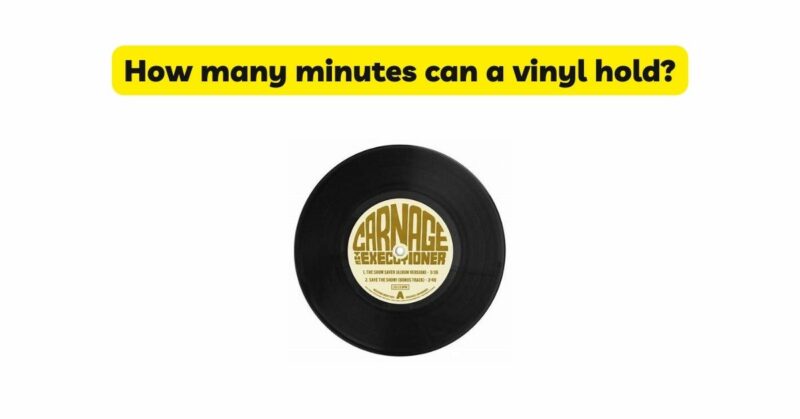Vinyl records have experienced a resurgence in popularity, captivating audiophiles with their warm sound and tactile charm. As a vinyl enthusiast, you may wonder about the duration a vinyl record can hold before requiring a flip or change. In this article, we will explore the factors that determine the playing time of a vinyl record and discuss the average duration across different formats. By understanding the variables that affect vinyl record duration, you can make informed decisions about your listening sessions and gain a deeper appreciation for the unique qualities of vinyl records.
I. Vinyl Record Formats and Playing Time
Vinyl records are available in various formats, each with its own playing time limitations. Let’s explore the most common formats and their average playing times:
- 7-inch Single: A 7-inch single typically contains one song per side. On average, each side can play for approximately 3 to 5 minutes, resulting in a total playing time of 6 to 10 minutes.
- 10-inch EP (Extended Play): A 10-inch EP can hold a few songs per side. The average playing time for each side is around 10 to 15 minutes, resulting in a total playing time of 20 to 30 minutes.
- 12-inch LP (Long Play) Album: A 12-inch LP album is the most common format for full-length albums. It can contain multiple songs per side and offers longer playing times. On average, each side of an LP album can play for approximately 15 to 25 minutes, resulting in a total playing time of 30 to 50 minutes.
- 12-inch Single: Occasionally, 12-inch singles are released, particularly in the dance and electronic music genres. These singles can offer extended playing times, ranging from 8 to 15 minutes per side or more.
II. Factors Affecting Vinyl Record Duration
Several factors influence the playing time of a vinyl record. Understanding these factors can provide insights into the limitations and considerations when enjoying vinyl records:
- Record Size: The physical size of the record directly affects the available space for grooves and audio content. Larger records, such as 12-inch LPs, have more surface area for grooves, allowing for longer playing times compared to smaller formats like 7-inch singles.
- Groove Spacing: The spacing between grooves determines the amount of audio content that can be engraved on the record. Closer groove spacing reduces the available playing time, while wider spacing allows for longer durations.
- Record Speed: The standard playback speed for vinyl records is 33 1/3 revolutions per minute (RPM) for LPs and 45 RPM for singles. Some records, particularly 12-inch singles, can be played at 78 RPM for faster playback. The speed affects the playing time, with faster speeds resulting in shorter durations.
- Groove Length and Width: The length and width of the grooves determine the amount of audio information that can be stored. Records with longer and wider grooves can accommodate more audio content, allowing for extended playing times.
- Track Length and Number: The length of individual tracks and the number of tracks on a side also contribute to the overall playing time. Albums with longer tracks or a higher number of tracks may have shorter playing times per side to accommodate the content.
III. Optimizing Vinyl Record Duration and Care Tips
To maximize the playing time of your vinyl records and ensure optimal sound quality, consider the following tips:
- Proper Turntable Setup: Ensure your turntable is properly set up, calibrated, and maintained. Correct tracking force, alignment, and stylus condition contribute to accurate tracking and minimize unnecessary wear on the record.
- Record Cleaning: Keep your records clean and free from dust, dirt, and fingerprints. Regularly clean them using a carbon fiber brush or a record cleaning solution to maintain the quality of the grooves and minimize surface noise.
- Handling and Storage: Handle records with care, holding them by the edges to avoid fingerprints and accidental scratches. Store records in protective sleeves and upright positions to prevent warping and damage.
- Flipping Records: When playing longer albums or EPs, be prepared to flip the record to the other side for continuous listening. Handle the record gently, ensuring that the stylus is lifted before flipping to avoid any damage.
Conclusion
The playing time of a vinyl record varies depending on factors such as format, record size, groove spacing, and track length. Understanding these variables allows you to appreciate the limitations and considerations when enjoying vinyl records. On average, 7-inch singles play for 6 to 10 minutes, 10-inch EPs play for 20 to 30 minutes, 12-inch LP albums play for 30 to 50 minutes, and 12-inch singles can offer extended playing times. By optimizing your turntable setup, properly cleaning and handling your records, and being mindful of their limitations, you can enjoy extended listening sessions while preserving the longevity and sound quality of your vinyl collection. Embrace the unique experience of vinyl and immerse yourself in the captivating soundscapes that this timeless format offers.


